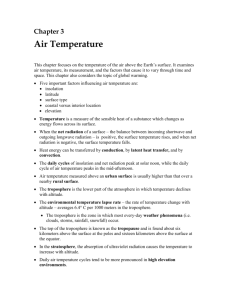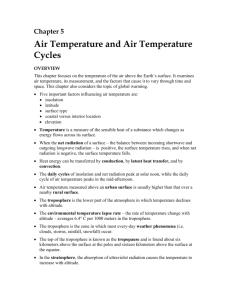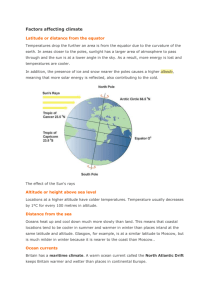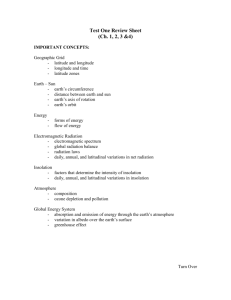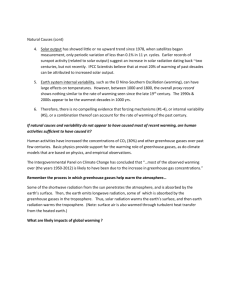Chapter 5
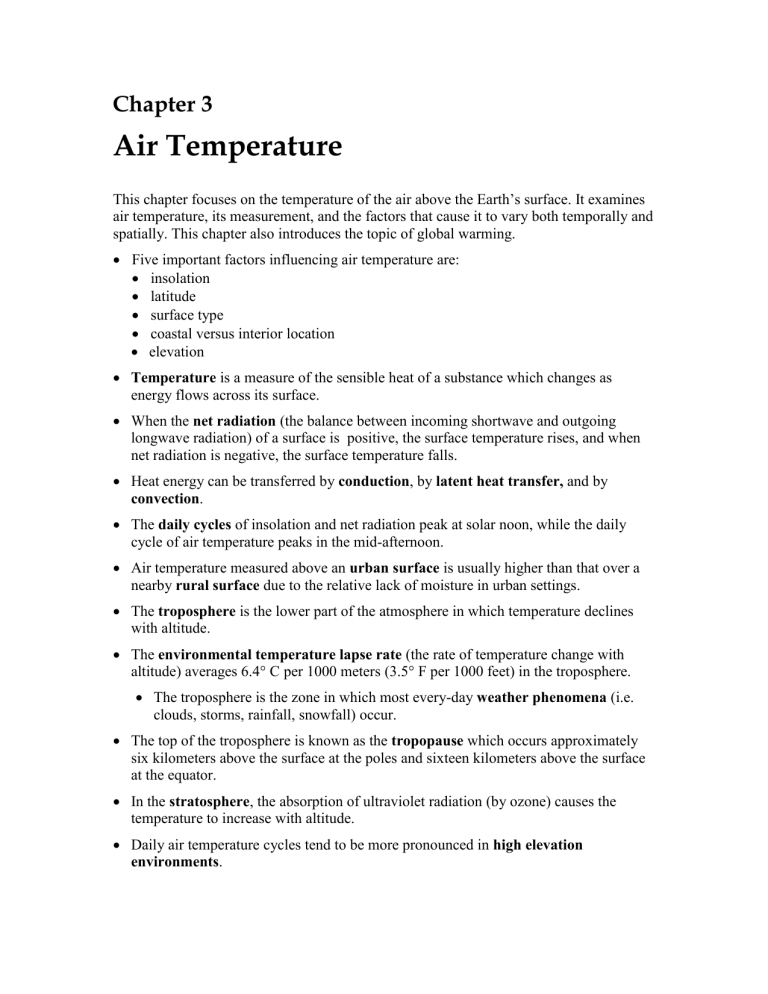
Chapter 3
Air Temperature
This chapter focuses on the temperature of the air above the Earth’s surface. It examines air temperature, its measurement, and the factors that cause it to vary both temporally and spatially. This chapter also introduces the topic of global warming.
Five important factors influencing air temperature are:
insolation
latitude
surface type
coastal versus interior location
elevation
Temperature is a measure of the sensible heat of a substance which changes as energy flows across its surface.
When the net radiation (the balance between incoming shortwave and outgoing longwave radiation) of a surface is positive, the surface temperature rises, and when net radiation is negative, the surface temperature falls.
Heat energy can be transferred by conduction , by latent heat transfer, and by convection .
The daily cycles of insolation and net radiation peak at solar noon, while the daily cycle of air temperature peaks in the mid-afternoon.
Air temperature measured above an urban surface is usually higher than that over a nearby rural surface due to the relative lack of moisture in urban settings.
The troposphere is the lower part of the atmosphere in which temperature declines with altitude.
The environmental temperature lapse rate (the rate of temperature change with altitude) averages 6.4° C per 1000 meters (3.5° F per 1000 feet) in the troposphere.
The troposphere is the zone in which most every-day weather phenomena (i.e. clouds, storms, rainfall, snowfall) occur.
The top of the troposphere is known as the tropopause which occurs approximately six kilometers above the surface at the poles and sixteen kilometers above the surface at the equator.
In the stratosphere , the absorption of ultraviolet radiation (by ozone) causes the temperature to increase with altitude.
Daily air temperature cycles tend to be more pronounced in high elevation environments .
In a temperature inversion , the normal situation of air cooling with altitude is reversed and air warms with altitude.
Yearly temperature ranges are greater in high latitude and continental locations and lower at equatorial and coastal locations.
The world patterns of isotherms are largely explained by latitude, coastal-interior contrasts, and elevation.
Six important points about temperature patterns are:
Temperatures decrease from the equator to the poles.
Large landmasses in the subarctic and arctic develop centers of extremely low temperatures in winter.
Temperatures in equatorial regions change little from January to July.
Isotherms make a large north-south shift from January to July over continents in the midlatitude and subarctic zones.
Highlands are colder than their surrounding lowlands.
Areas of perpetual ice and snow are intensely cold.
Five important points about temperature range are:
The annual temperature range increases with latitude.
The greatest ranges are in the subarctic and arctic zones of Asia and North
America.
Annual range is moderately large on land in the tropical zone.
Annual range in coastal areas is less than the range inland at the same latitude.
Small temperature ranges are found near oceans in the tropical zone.
Factors affecting global warming and cooling include:
greenhouse gases
tropospheric aerosols
cloud changes
land cover changes
changes in solar output
aerosols from volcanic activity
The warming effect of the greenhouse gases (carbon dioxide, methane, nitrous oxides, ozone, and chloroflourocarbons) has exceeded the cooling effect of other factors since approximately 1850.
Observations show both substantial annual variations in the average temperature of the lower atmosphere and a pronounced trend toward warmer temperatures in recent years.
Most scientists agree that the observed atmospheric warming trend is the result of greenhouse gas emissions from human activities and that the warming trend will likely continue into the future.
